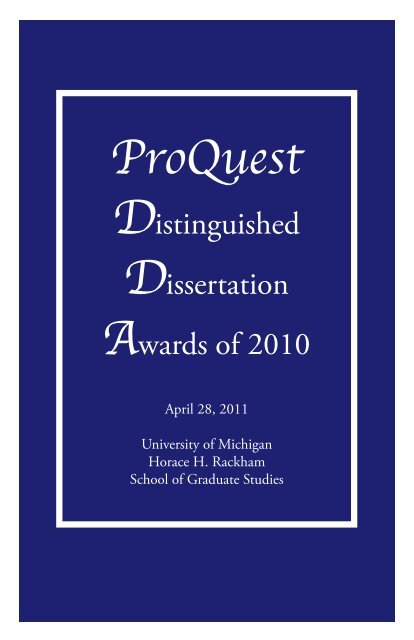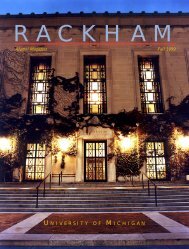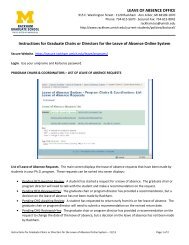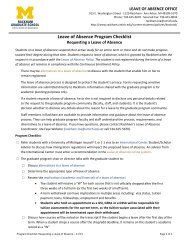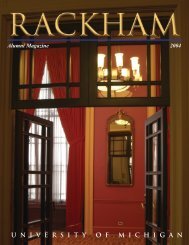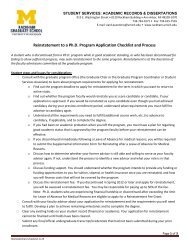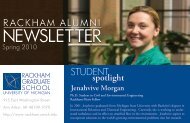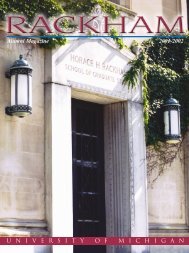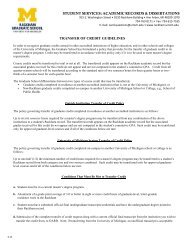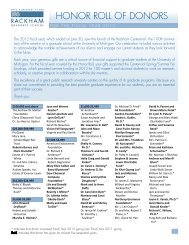ProQuest - Rackham Graduate School - University of Michigan
ProQuest - Rackham Graduate School - University of Michigan
ProQuest - Rackham Graduate School - University of Michigan
You also want an ePaper? Increase the reach of your titles
YUMPU automatically turns print PDFs into web optimized ePapers that Google loves.
<strong>ProQuest</strong><br />
Distinguished<br />
Dissertation<br />
Awards <strong>of</strong> 2010<br />
April 28, 2011<br />
<strong>University</strong> <strong>of</strong> <strong>Michigan</strong><br />
Horace H. <strong>Rackham</strong><br />
<strong>School</strong> <strong>of</strong> <strong>Graduate</strong> Studies
W<br />
hile all graduating <strong>Rackham</strong> students produce<br />
excellent dissertations, some students write<br />
dissertations that are truly exceptional for the high<br />
quality <strong>of</strong> their scholarship and for the significance<br />
and interest <strong>of</strong> their findings. We recognize these exceptional<br />
dissertations with the <strong>ProQuest</strong> Distinguished Dissertation Award.<br />
Dissertations are nominated for the award by <strong>University</strong><br />
faculty who have served as chairs <strong>of</strong> dissertation committees <strong>of</strong><br />
outstanding students. The nominations are then read by a review<br />
panel composed <strong>of</strong> members <strong>of</strong> the <strong>Michigan</strong> Society <strong>of</strong> Fellows,<br />
with assistance from other members <strong>of</strong> the <strong>University</strong> faculty and<br />
research community.<br />
The awards are co-sponsored by <strong>ProQuest</strong>, which publishes nearly<br />
80,000 dissertations and theses annually, including more than 700<br />
by <strong>University</strong> <strong>of</strong> <strong>Michigan</strong> authors. We are delighted to have them<br />
join us in celebrating the remarkable intellectual achievements <strong>of</strong><br />
these promising young scholars.<br />
The <strong>Rackham</strong> <strong>Graduate</strong> <strong>School</strong> takes great pleasure in honoring<br />
these outstanding members <strong>of</strong> the community <strong>of</strong> scholars.<br />
Janet A. Weiss<br />
Dean and Vice Provost for Academic Affairs
Playing Out: Women Instrumentalists and Women’s<br />
Ensembles in Contemporary Tunisia<br />
Alyson E. Jones<br />
Musicology<br />
B.A., Music (minor in Sociology & Anthropology), Swarthmore College, 2002<br />
M.A., Musicology (Ethnomusicology), <strong>University</strong> <strong>of</strong> <strong>Michigan</strong>, 2006<br />
Ph.D., Musicology (Ethnomusicology), <strong>University</strong> <strong>of</strong> <strong>Michigan</strong>, 2010<br />
This dissertation <strong>of</strong>fers a thoughtful, carefully detailed ethnographic account <strong>of</strong> the<br />
role <strong>of</strong> female instrumentalists in Tunisia, addressing, as the author argues, a significant<br />
cultural shift in gender roles in Tunisian music. The author explores questions <strong>of</strong> identity,<br />
primarily focusing on the relationship between Tunisian national identity and female<br />
identity, negotiated and re-imagined by the female performers no longer relegated to a<br />
musical practice limited to being vocalists. To describe these women’s lives and musicmaking,<br />
the author coins the term “playing out,” referencing the women’s public turn<br />
in their performances and the confidence and agency they demonstrate through their<br />
approaches to music. The dissertation’s primary insight, focusing on how the women feel<br />
about the cultural negotiations they must make in order to make music as they wish, is<br />
done with care and depth—obviously a product <strong>of</strong> reflexive ethnographic work. Some <strong>of</strong><br />
the work’s most far-reaching contributions emerge as the author bridges feminist theory,<br />
performance studies, play theory, and musicology to create a frame appropriate for seeing<br />
not just the women’s performances as negotiating national and gender identities imposed<br />
upon them, but as actors in a larger cultural drama. From this dissertation, one gains a<br />
perspective from a group heret<strong>of</strong>ore understudied in ethnomusicology and a group <strong>of</strong><br />
female artists whose work will contribute to discussions <strong>of</strong> global feminisms. This dissertation’s<br />
detailed descriptions, ranging from descriptions <strong>of</strong> performance scenarios to<br />
accounts <strong>of</strong> relationships with narrators, and the careful interpretations Jones draws from<br />
these descriptions will make this scholarly work accessible to a range <strong>of</strong> fields across the<br />
humanities and the arts.<br />
– Comments by Clare Cr<strong>of</strong>t<br />
Dissertation Committee:<br />
Judith Becker, Co-Chair<br />
Christi-Anne Castro, Co-Chair<br />
Naomi Andre, Cognate<br />
Marcia Inhorn<br />
Joseph Lam
The Past Jumps Up: British Radicals and the Remaking <strong>of</strong><br />
Literary History, 1790-1870<br />
Casie R. LeGette<br />
English Language & Literature<br />
B.A., English, <strong>University</strong> <strong>of</strong> Georgia, 2004<br />
M.A., English, <strong>University</strong> <strong>of</strong> Georgia, 2004<br />
Ph.D., English Language and Literature, <strong>University</strong> <strong>of</strong> <strong>Michigan</strong>, 2010<br />
“The Past Jumps Up: British Radicals and the Remaking <strong>of</strong> Literary History, 1790-<br />
1870” is an impressive study <strong>of</strong> the redeployment <strong>of</strong> literary fragments, primarily from<br />
the early Romantic period, in Victorian periodicals. It examines the ways in which<br />
radical publishers in England reinterpreted (and basically remade) a literary tradition<br />
that better suited their political needs and audiences in the long nineteenth century. The<br />
potential contribution <strong>of</strong> the study to the existing secondary literature is clear: “The Past<br />
Jumps Up” fits nicely with, and extends, emerging work in book history in the Victorian<br />
era, and it <strong>of</strong>fers a vital revisionist understanding <strong>of</strong> the popular reception <strong>of</strong> Romantic<br />
literature (which, by the 1800s, was being coded as conservative) from a materialist<br />
standpoint. LeGette’s focus on forgetting, loss, and fragments in the archive is novel and<br />
exciting, consistently pushing beyond the empirical into interpretation. The dissertation<br />
is also ambitious and bold in taking on the nagging <strong>of</strong>-the-moment question <strong>of</strong> how<br />
book history relates to literary criticism and vice versa. It successfully moves from the<br />
archive to the text and back again, producing insights that will be <strong>of</strong> great interest to<br />
both historians <strong>of</strong> the period and traditional scholars <strong>of</strong> Wordsworth, Godwin, Southey,<br />
and Coleridge.<br />
– Comments by Jeffrey Knight<br />
Dissertation Committee:<br />
Adela Pinch, Chair<br />
Kali Israel, Cognate<br />
Daniel Hack<br />
Marjorie Levinson<br />
Martha Vicinus
Toward a Holistic Understanding <strong>of</strong> Academic Identification in<br />
Ethnic Minority Boys at Risk for Academic Failure<br />
Jamaal S. Matthews<br />
Education and Psychology<br />
B.A., Psychology, Columbia <strong>University</strong>, 2003<br />
M.A., Urban Education, Mercy College, 2005<br />
M.S., Developmental Psychology, <strong>University</strong> <strong>of</strong> <strong>Michigan</strong>, 2007<br />
Ph.D., Education & Psychology, <strong>University</strong> <strong>of</strong> <strong>Michigan</strong>, 2010<br />
Jamaal Matthews’ dissertation begins by reminding the reader that the stakes <strong>of</strong> academic<br />
identification are high. Studies have shown that African American and Latino boys<br />
are disproportionately likely to fall behind in junior high and high school, and academic<br />
identification is part <strong>of</strong> why this happens. Yet exactly how academic identification matters<br />
for minority boys remains understudied. To correct for this, Dr. Matthews surveyed<br />
653 middle and high school students in schools in Harlem and the South Bronx. Finding<br />
no identification gap between boys and girls in his study, and taking the additional<br />
step <strong>of</strong> honing in on the experiences <strong>of</strong> at-risk boys, Dr. Matthews overturns the simplistic<br />
notion that African American and Latino boys reject academic identification out-<strong>of</strong>hand.<br />
Instead, he identifies multiple pathways through which these boys may identify<br />
with their schools. A sense <strong>of</strong> belonging and competency at school and outside <strong>of</strong> it, a<br />
sense <strong>of</strong> connection to specific teachers or to groups <strong>of</strong> friends, a sense <strong>of</strong> the importance<br />
<strong>of</strong> education, and a capacity to self-regulate all combine to affect academic identification.<br />
The research design – with its large sample <strong>of</strong> at-risk boys and close attention to<br />
teasing out the various forms <strong>of</strong> academic identification – allows Dr. Matthews to shine<br />
new light on the complex and <strong>of</strong>ten affirmative range <strong>of</strong> school-related understandings,<br />
attitudes, and experiences <strong>of</strong> these adolescents. Jamaal Matthews’ holistic approach, with<br />
its novel methodology and findings, should be <strong>of</strong> interest to scholars and policymakers<br />
who care about education and inequality. It is an important step toward devising better<br />
and more precise education policies, and it successfully challenges the tendency to<br />
homogenize the experiences and attitudes <strong>of</strong> at-risk boys.<br />
– Comments by Sarah Quinn<br />
Dissertation Committee:<br />
Stephanie Rowley, Chair<br />
Robert Jagers, Cognate<br />
Jennifer Crocker<br />
John Schulenberg
Design and Fabrication <strong>of</strong> Integrated Micr<strong>of</strong>luidic Circuits<br />
Using Normally-Closed Elastomeric Valves<br />
Bobak Mosadegh<br />
Biomedical Engineering<br />
B.S., Biomedical Engineering-biophotonics specialization, <strong>University</strong> <strong>of</strong> California, 2006<br />
M.S., Biomedical Engineering, <strong>University</strong> <strong>of</strong> California, 2006<br />
Ph.D., Biomedical Engineering, <strong>University</strong> <strong>of</strong> <strong>Michigan</strong>, 2010<br />
The thesis by Bobak Mosadegh reports the development <strong>of</strong> novel micr<strong>of</strong>luidic circuits<br />
and their use for cellular patterning. The initial part <strong>of</strong> the thesis (chapters 1-4) is a<br />
thorough analysis <strong>of</strong> the parameters that lead to the micr<strong>of</strong>luidic circuits used in later<br />
studies. The approach contains both mathematical analysis and experimental realization<br />
and provides a detailed description <strong>of</strong> the individual design aspects that were accounted<br />
for in this thesis. Parts <strong>of</strong> this work have resulted in a publication in Nature Physics.<br />
The real strength <strong>of</strong> the thesis, however, lies in the ingenious use <strong>of</strong> integrated micr<strong>of</strong>luidic<br />
systems as cell patterning and dispensing systems. By doing so, this work addresses<br />
one <strong>of</strong> the overarching challenges <strong>of</strong> in vitro cell culture, i.e., how to create complex<br />
co-patterns <strong>of</strong> different types <strong>of</strong> cells in variable proximity. This work is described in<br />
Chapters 5 to 10 and has led to a number <strong>of</strong> high-impact publications in journals such<br />
as Nature Materials.<br />
In summary, this is a truly outstanding thesis, both with respect to quantity and quality<br />
<strong>of</strong> the work. The thesis itself is well-structured and logical and it is easy to follow the<br />
red lining throughout the thesis. Mathematical analysis, experimental design and data<br />
analysis are rigorous and satisfy highest academic standards.<br />
– Comments by Pr<strong>of</strong>essor Joerg Lahann<br />
Dissertation Committee:<br />
Shuichi Takayama, Chair<br />
Mark Burns, Cognate<br />
Katharine Barald<br />
Mohamed El-Sayed
Who Moved My Protein? Mechanisms <strong>of</strong> Epileptogenesis Due<br />
to Mutations <strong>of</strong> Voltage-Gated Sodium Channel SCN1B<br />
Gustavo A. Patino<br />
Neuroscience<br />
M.D., Medical <strong>School</strong>, Universidad Nacional de Colombia, 2000<br />
Ph.D., Neuroscience, <strong>University</strong> <strong>of</strong> <strong>Michigan</strong>, 2010<br />
This superbly crafted thesis describes a multi-faceted experimental approach to explore<br />
how specific human mutations in SCN1B (a gene that encodes for a sodium channel<br />
beta subunit) cause a severe form <strong>of</strong> epilepsy known as Dravet syndrome. The author<br />
combines molecular techniques, rigorous electrophysiological analysis <strong>of</strong> channel currents,<br />
bioinformatics, and sophisticated biochemical approaches to show that a diseasecausing<br />
mutation in SCN1B abolishes the function <strong>of</strong> this protein due to a specific<br />
“trafficking” defect that prevents the subunit from reaching the cell surface. Using genetically<br />
engineered mice that lack both copies <strong>of</strong> SCN1B, the author provides evidence<br />
that Dravet syndrome caused by loss <strong>of</strong> SCN1B function is likely due to overactivity<br />
<strong>of</strong> excitatory neurons in neural circuits, rather than the loss <strong>of</strong> inhibition. Remarkably,<br />
although mutations in pore-forming alpha subunits <strong>of</strong> sodium channels can also cause<br />
Dravet syndrome, Dr. Patino provides evidence that some disease-causing mutations<br />
in SCN1B promote epilepsy, not via direct regulation <strong>of</strong> sodium channel function, but<br />
rather through defective secretion <strong>of</strong> a cell adhesion molecule that the SCN1B gene<br />
locus encodes. Collectively, this extraordinary body <strong>of</strong> work is both meticulous and<br />
creative, providing a detailed characterization <strong>of</strong> mutant SCN1B and an innovative<br />
hypothesis for why such mutations cause seizures. This beautifully written thesis will<br />
impress specialists for its scholarship and its breadth, yet is easily accessible to those<br />
outside the field as well.<br />
– Comments by Pr<strong>of</strong>essor Michael Sutton<br />
Dissertation Committee:<br />
Lori Isom, Chair<br />
Miriam Meisler<br />
Ge<strong>of</strong>frey Murphy<br />
Jack Parent<br />
Michael Uhler
Exploring the Fractures within Human Rights: An Empirical<br />
Study <strong>of</strong> Resistance<br />
Christopher N. Roberts<br />
Public Policy and Sociology<br />
B.A., Anthropology, <strong>University</strong> <strong>of</strong> California, 1997<br />
J.D., Law <strong>School</strong>, <strong>University</strong> <strong>of</strong> California, 2000<br />
Ph.D., Public Policy & Sociology, <strong>University</strong> <strong>of</strong> <strong>Michigan</strong>, 2010<br />
Dr. Roberts’ dissertation is an ambitious and well-executed historical study <strong>of</strong> the processes<br />
and struggles that led to the formulation and ultimate adoption <strong>of</strong> the International<br />
Bill <strong>of</strong> Human Rights. The foundational premise—both pr<strong>of</strong>oundly insightful<br />
and provocative—is that the long-acknowledged gap between human rights ideals and<br />
practice cannot be explained away as a lack <strong>of</strong> political will or enforcement capacity.<br />
Rather, it results from fundamental ambiguities and contradictions that are built into<br />
the agreements themselves and that reflect the various social conflicts that shaped the<br />
production <strong>of</strong> these agreements. Previous studies <strong>of</strong> human rights—and <strong>of</strong> the IBHR<br />
in particular—have tended to approach the topic from the perspectives <strong>of</strong> international<br />
politics, law, and/or philosophy. Roberts demonstrates that such approaches are insufficient<br />
ins<strong>of</strong>ar as they neglect the social context <strong>of</strong> treaty negotiations. With meticulous<br />
archival research, he exhumes and reconstructs a detailed history <strong>of</strong> the social relations<br />
and conflicts—especially those shaped by the Cold War, the decline <strong>of</strong> colonialism,<br />
and U.S. race relations—that undergirded the institutionalization <strong>of</strong> an international<br />
rights regime. Roberts’ focus on the social also has an important methodological corollary:<br />
whereas previous scholarship has worked backwards from those rights currently<br />
enshrined in law to their origins in previous theoretical ideals and negotiations, the fact<br />
that Roberts begins with historically-situated social relations encourages him to take a<br />
prospective approach. This makes it possible to identify those conflicts that shaped negotiations<br />
as they unfolded—even when the controversial issues were ultimately dropped<br />
from or otherwise not reflected in finished law. Equally impressive is Roberts’ ability to<br />
treat subject matter as potentially arcane as State Department policy, treaty negotiations,<br />
and international law with an ease that should render the core argument both clear and<br />
compelling to broad popular and undergraduate audiences.<br />
– Comments by Robert Jansen<br />
Dissertation Committee:<br />
Margaret Somers, Co-Chair<br />
Susan Waltz, Co-Chair<br />
Elizabeth Anderson, Cognate<br />
Michael Kennedy<br />
Kiyoteru Tsutsui
Jumping Numbers and Multiplier Ideals on Algebraic Surfaces<br />
Kevin F. Tucker<br />
Mathematics<br />
B.A., Mathematics, <strong>University</strong> <strong>of</strong> Chicago, 2004<br />
Ph.D., Mathematics, <strong>University</strong> <strong>of</strong> <strong>Michigan</strong>, 2010<br />
Kevin Tucker’s thesis studies singularities <strong>of</strong> complex algebraic varieties. These arise as<br />
simultaneous solutions <strong>of</strong> systems <strong>of</strong> polynomial equations in several variables. This<br />
is a higher dimensional analogue <strong>of</strong> graphing equations in the plane, but one looks at<br />
the solutions over the complex numbers, not just the real numbers, and there are many<br />
variables occurring in several equations. But one can still think <strong>of</strong> the solutions as a<br />
geometric object, just as solutions <strong>of</strong> x2+y2 = 1 form a circle in the plane.<br />
Some solution sets are called smooth. The circle and the sphere are smooth. Intuitively,<br />
to a tiny creature living on it, a smooth variety “looks” flat, like a line, a plane, or a<br />
higher dimensional analogue <strong>of</strong> these. When the set is not smooth near a point, it is<br />
said to have a singularity. This happens when the variety is pointy, like a cone, or has<br />
a crease, or passes through itself. Singularities can be very complicated. It is <strong>of</strong> central<br />
importance in algebraic geometry to understand and classify possible singularities in<br />
higher dimension.<br />
This brilliant thesis compares properties <strong>of</strong> singularities defined originally using ideas<br />
from calculus, like the behavior <strong>of</strong> integrals, with other properties defined by replacing<br />
the complex numbers by a discrete algebraic system (e.g., a finite field) while somehow<br />
capturing essential features <strong>of</strong> the singularity.<br />
There has been a great deal <strong>of</strong> interest recently in the behavior <strong>of</strong> multiplier ideals, a<br />
nested family <strong>of</strong> objects indexed by a real parameter, and jumping numbers, which are the<br />
values <strong>of</strong> the parameter where the multiplier ideals change. The thesis includes characterizations<br />
for certain surfaces <strong>of</strong> which ideals can be multiplier ideals, and develops, again<br />
for certain surfaces, an effective method <strong>of</strong> calculating jumping numbers. This research is<br />
beautiful, striking, and will have lasting impact on the field. Moreover, the thesis does a<br />
wonderful job <strong>of</strong> explaining a very difficult subject.<br />
– Comments by Pr<strong>of</strong>essor Mel Hochster<br />
Dissertation Committee:<br />
Karen Smith, Chair<br />
James Tappenden, Cognate<br />
Mattias Jonsson<br />
Robert Lazarsfeld<br />
Mircea Mustata
Structural Analyses <strong>of</strong> Telomere Associated Proteins<br />
Feng Wang<br />
Biological Chemistry<br />
B.S., Molecular and Cellular Biology, <strong>University</strong> <strong>of</strong> Science and Technology <strong>of</strong> China, 2004<br />
Ph.D., Biological Chemistry, <strong>University</strong> <strong>of</strong> <strong>Michigan</strong>, 2010<br />
Telomeres cap the ends <strong>of</strong> linear chromosomes in eukaryotic cells and proper telomere<br />
maintenance is critical to ensure genome integrity and stability. During his thesis dissertation<br />
research, Dr. Feng Wang determined the three-dimensional structures and<br />
biochemical functions <strong>of</strong> three protein complexes that play important roles in maintaining<br />
telomere structure and function. First, Dr. Wang demonstrated that the two<br />
proteins, TPP1 and POT1, act in concert to increase the processive nature <strong>of</strong> telomerase,<br />
an enzyme which is critical for maintaining proper telomere length. Dr. Wang then used<br />
computational analyses in conjunction with biochemical studies to uncover similarities<br />
between TPP1 and a yeast protein that is critical for yeast telomerase activity, EST3.<br />
Second, Dr. Wang demonstrated that Taz1, a telomere associated protein from the fission<br />
yeast S. pombe, shares functional similarities to proteins in higher eukaryotes that<br />
are critical for maintaining proper telomere structure (TRF1 and TRF2), despite the fact<br />
that these proteins differ in their structural properties. Thus, Dr. Wang’s studies provide<br />
an illustrative example <strong>of</strong> how structurally distinct proteins can evolve different strategies<br />
to perform similar biochemical functions. Finally, Dr. Wang has determined the<br />
structures <strong>of</strong> two proteins, RMI1 and RMI2, which are critical for maintaining genome<br />
integrity. Dr. Wang’s thesis research represents a tour de force and already has led to publications<br />
in Nature and Nature Structural and Molecular Biology. The work is substantial,<br />
the thesis is extremely well written, and the work is <strong>of</strong> the highest scholarship and has<br />
generated important new insights about telomere biology. Dr. Wang should be tremendously<br />
proud <strong>of</strong> his outstanding accomplishments.<br />
– Comments by Pr<strong>of</strong>essor John Moran<br />
Dissertation Committee:<br />
Ming Lei, Chair<br />
Gary Hammer, Cognate<br />
Robert Fuller<br />
Janet Smith<br />
Zhaohui Xu
Dea H. Boster<br />
History<br />
Martin Pernick, Chair<br />
Tobin Siebers, Cognate<br />
Joel Howell<br />
Martha Jones<br />
Laura A. Cooney<br />
Immunology<br />
David Fox, Co-Chair<br />
James Ferrara<br />
Mariana Kaplan<br />
Philip King<br />
Nicholas Lukacs<br />
Megan H. Hagenauer<br />
Neuroscience<br />
Theresa Lee, Chair<br />
Daniel Forger, Cognate<br />
Jill Becker<br />
Jimo Borjigin<br />
Robert Thompson<br />
Michael A. Kicey<br />
Comparative Literature<br />
James Porter, Co-Chair<br />
L. Ross Chambers, Co-Chair<br />
David Halperin<br />
Dean Hammer<br />
Marjorie Levinson<br />
Vassilios Lambropoulos<br />
Honorable Mention<br />
Navaneetha Mokkil-Maruthur<br />
English Language and Literature<br />
Anne Herrmann, Co-Chair<br />
Maria See, Co-Chair<br />
Manishita Dass, Cognate<br />
Sumathi Ramaswamy<br />
Brian R. Peterson<br />
Mechanical Engineering<br />
Volker Sick, Chair<br />
James Driscoll, Cognate<br />
Dionissios Assanis<br />
Claus Borgnakke<br />
Xia<strong>of</strong>eng Yang<br />
Kristen S. Seefeldt<br />
Public Policy and Sociology<br />
Sheldon Danziger, Co-Chair<br />
Pamela Smock, Co-Chair<br />
Mary Corcoran<br />
Alford Young
Distinguished Dissertation Award Nominees<br />
Michelle Barton<br />
Business Administration<br />
Kathleen Sutcliffe, Chair<br />
Laura Brown<br />
Anthropology<br />
Judith Irvine, Chair<br />
Elana Buch<br />
Social Work & Social Science<br />
Ruth Dunkle, Co-Chair<br />
Gillian Feeley-Harnik, Co-Chair<br />
Xu Chen<br />
Computer Science & Engineering<br />
Zhuoqing Mao, Chair<br />
Elena Torre<br />
Romance Language and Literature<br />
Jarrod Hayes, Co-Chair<br />
Peggy McCracken, Co-Chair<br />
Paul Duffy<br />
Anthropology<br />
John O’Shea, Chair<br />
Qing Fang<br />
Human Genetics<br />
Sally Camper, Chair<br />
Katherine Gotham<br />
Psychology<br />
Catherine Lord, Chair<br />
Emanuela Grama<br />
Anthropology & History<br />
Gillian Feeley-Harnik, Co-Chair<br />
Katherine Verdery, Co-Chair<br />
Wei Guo<br />
Materials Science and Engineering<br />
Xiaoqing Pan, Chair<br />
Edward Jan<br />
Chemical Engineering<br />
Nicholas Kotov, Chair<br />
Lian Jian<br />
Information<br />
Jeffrey MacKie-Mason, Chair<br />
Sung Hyun Jo<br />
Electrical Engineering<br />
Wei Lu, Chair<br />
Konstantia Kapetangianni<br />
Linguistics<br />
Samuel Epstein, Co-Chair<br />
Acrisio Pires, Co-Chair<br />
Courtney Kennedy<br />
Survey Methodology<br />
Michael Traugott, Chair<br />
Dinesh Krithivasan<br />
Electrical Engineering-Systems<br />
Sandeep Sadanandarao, Chair<br />
Catherine Kublik<br />
Applied & Interdisciplinary<br />
Mathematics<br />
Selim Esedoglu, Co-Chair<br />
Jeffrey Fessler, Co-Chair<br />
Adam Levine<br />
Political Science<br />
Arthur Lupia, Chair<br />
Jennifer Mason<br />
Human Genetics<br />
Joann Sekiguchi, Chair<br />
Douglas Mullen<br />
Macromolecular Science & Engineering<br />
Mark Banaszak Holl, Chair
Thomas Neeson<br />
Natural Resources and Environment<br />
Sara Adlerstein-Gonzalez, Co-Chair<br />
Michael Wiley, Co-Chair<br />
Kristen Pellegrino<br />
Music Education<br />
Marie McCarthy, Chair<br />
Shu Quan<br />
Molecular, Cellular &<br />
Developmental Biology<br />
James Bardwell, Chair<br />
Ali Shojaie<br />
Statistics<br />
George Michailidis, Chair<br />
Matthew Stiffler<br />
American Culture<br />
Nadine Naber, Chair<br />
Seda Yilmaz<br />
Philosophy<br />
Jan-Henrik Andersen, Co-Chair<br />
Colleen Seifert, Co-Chair<br />
Sukhwan Yoon<br />
Environmental Engineering<br />
Jeremy Semrau, Chair<br />
Gwen Yu<br />
Business Administration Accounting<br />
Russell Lundholm, Chair<br />
Fang Yuan<br />
Physics<br />
Carl Akerl<strong>of</strong>, Chair
The <strong>Graduate</strong> <strong>School</strong> wishes to acknowledge the special contributions <strong>of</strong><br />
the Society <strong>of</strong> Fellows, whose members contributed a significant amount<br />
<strong>of</strong> time and energy to the review and selection process. We also thank the<br />
other members <strong>of</strong> the <strong>University</strong> faculty and research community who<br />
assisted them. By making these awards possible, all <strong>of</strong> these scholars have<br />
contributed in a meaningful way to the <strong>University</strong>’s intellectual life.<br />
<strong>Michigan</strong> Society <strong>of</strong> Fellows<br />
Sepideh Bajracharya<br />
Anya Bernstein<br />
Claudia Brittenham<br />
Lily Cox-Richard<br />
Clare Cr<strong>of</strong>t<br />
Evan Economo<br />
Roger Grant<br />
Moira Gresham<br />
Zeynep Gursel<br />
Manja Holland<br />
Faculty Reviewers<br />
Melvin Hochster<br />
Joerg Lahann<br />
John Moran<br />
Michael Sutton<br />
Robert Jansen<br />
Tung-Hui Hu<br />
Jeffrey Knight<br />
Elise Lipkowitz<br />
Sara McClelland<br />
Sarah Quinn<br />
Elena Rasia<br />
Christopher Skeaff<br />
Selena Smith<br />
Carrie Booth Walling<br />
<strong>Rackham</strong> <strong>Graduate</strong> <strong>School</strong> Staff<br />
Alec Gallimore<br />
Colleen Root<br />
Homer Rose<br />
Elyse Rubin<br />
Lynne Shivers<br />
Cindy Sutton<br />
Katie Vawters<br />
<strong>University</strong> <strong>of</strong> <strong>Michigan</strong><br />
Horace H. <strong>Rackham</strong> <strong>School</strong> <strong>of</strong> <strong>Graduate</strong> Studies
<strong>ProQuest</strong>’s UMI Dissertation Publishing was created<br />
in 1938 to safeguard threatened scholarly resources,<br />
and has been the dedicated steward <strong>of</strong> graduate works<br />
ever since. Our goal is to ensure that dissertations and<br />
theses are archived in perpetuity as a valuable component<br />
<strong>of</strong> the primary literature in every discipline.<br />
As a committed supporter <strong>of</strong> graduate education,<br />
UMI Dissertation Publishing appreciates the opportunity<br />
to co-sponsor the Distinguished Dissertation<br />
Awards along with the <strong>University</strong> <strong>of</strong> <strong>Michigan</strong>’s<br />
<strong>Rackham</strong> <strong>Graduate</strong> <strong>School</strong>.


